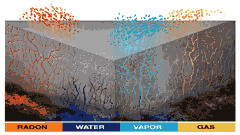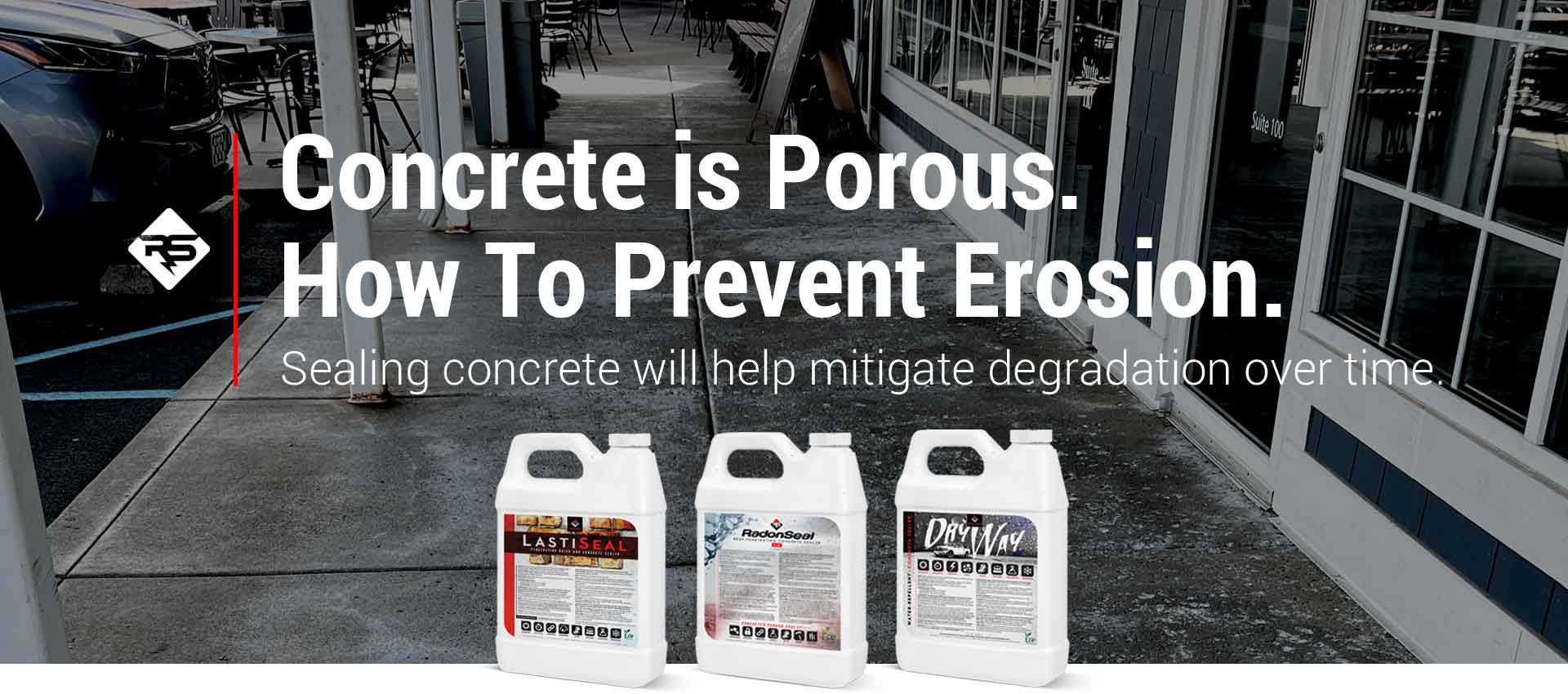Concrete Is More Porous Than You Think
Many homeowners assume concrete is solid and impermeable—but that’s far from the truth. In fact, concrete is surprisingly porous, with up to 18% of its volume made up of microscopic pores. These pores are invisible to the eye but significantly impact how concrete interacts with moisture, soil gases, and indoor air.
When concrete is poured, it contains excess water that must evaporate during curing. As that water escapes, it leaves behind a complex network of capillary pores. These pores are thousands of times larger than water molecules, allowing water vapor and soil gases like radon to pass through easily.
🔗 According to the EPA, radon gas can infiltrate homes through porous concrete and cracks in the foundation, increasing long-term health risks.
Liquid water is initially held back by surface tension inside dry pores—but once the concrete gets damp, water begins flowing through by capillary action, which actively pulls in moisture from the ground. Over time, this leads to a wide range of structural and indoor air quality problems.
⚡ Quick Summary
-
Concrete contains invisible pores that let moisture and soil gases pass through.
-
Once concrete becomes damp, capillary action draws in more water from the ground.
-
Sealing concrete early prevents long-term damage and improves indoor air quality.

Common Signs of Porous Concrete and Moisture-Related Damage
The effects of porous concrete often develop gradually but can escalate into serious structural and indoor air quality problems. Whether you’re dealing with a basement, crawlspace, garage, or outdoor slab, identifying the early warning signs of water intrusion, vapor migration, or radon infiltration is essential for long-term protection.
🔍 Signs of Porous Concrete Indoors
Unchecked moisture movement through basement walls or floors can lead to a variety of symptoms, including:
-
Water seepage through concrete basement walls or floor slabs, especially after rain or snowmelt
-
Cracks in foundation walls or floor slabs, allowing water and soil gases to enter more freely
-
Leaking construction joints, including cold joints, control joints, and expansion joints
-
Leaking around form ties or pipe penetrations, often sealed improperly or degraded over time
-
White, powdery efflorescence, caused by salts migrating to the surface through moisture pathways
-
Radon gas infiltration, especially through unsealed concrete or cracks under the slab
-
High indoor humidity levels in basements due to continuous water vapor intrusion
-
Musty odors, mold, and mildew growth, indicating trapped moisture and biological activity
-
Condensation on cold concrete surfaces, such as basement or garage floors, due to vapor intrusion
-
Concrete dusting, which contributes to respiratory irritants and can harm HVAC systems
-
Recurring sump pump failures or overflows, often caused by hydrostatic pressure under the slab
-
Wet or moldy crawlspaces, especially in homes without vapor barriers or sealed concrete
These symptoms can compromise your basement’s livability, reduce energy efficiency, and increase the risk of radon exposure—all of which make sealing and protecting concrete a top priority.
🌧️ Outdoor Concrete Problems Caused by Porosity
Exterior concrete and masonry surfaces are constantly exposed to weather, freeze-thaw cycles, and environmental pollutants. Porous materials deteriorate faster under these conditions:
-
Spalling or pitting on driveways, patios, or sidewalks, often due to freeze/thaw cycles and deicing salts
-
Cracks in driveways, pool decks, or outdoor slabs, exacerbated by thermal expansion and moisture intrusion
-
Leaking brick walls or chimneys, especially those exposed to wind-driven rain and poor drainage
-
Crumbling bricks or eroding mortar joints, signs of long-term moisture penetration and freeze damage
-
Efflorescence on concrete walls, pavers, or retaining walls, indicating ongoing vapor movement and salt migration
-
Deterioration of masonry and natural stone, particularly in poorly sealed or shaded areas
-
Pool deck cracking, staining, or surface erosion, often caused by pool chemicals and moisture cycling
-
Leaking fish ponds or water features, where porous concrete allows water to escape slowly
-
Salt corrosion in marine or coastal concrete structures, due to airborne chloride ions penetrating pores
-
Algae or mildew growth, especially on shaded or perpetually damp outdoor surfaces
-
Faded or blotchy concrete surfaces, which may indicate moisture cycling or require staining/sealing
What Makes the Problem Worse Over Time?
The calcium compounds in cement are water-soluble. As water continuously moves through the pores, it dissolves calcium, slowly enlarging the pore network. This accelerates concrete deterioration, even in basements that appear dry on the surface.
That’s why many homeowners first notice subtle signs—musty smells, elevated humidity, or minor surface discoloration—before full-on leaks or cracks appear. These are early warnings of vapor infiltration and pore expansion.

🔍 Did you know?
Concrete blocks (CMUs) and cinder blocks are far more porous than poured concrete—making them especially prone to seepage, radon, and efflorescence.
The Long-Term Solution: Deep-Sealing Concrete
Even if your basement or concrete slab looks dry, the risk of water vapor and soil gas infiltration remains. The most effective way to stop the problem before it grows is to deep-seal the concrete from within using a penetrating sealer like RadonSeal Deep-Penetrating Concrete Sealer.
RadonSeal:
-
Penetrates deeply into the concrete matrix
-
Seals pores and capillaries at the molecular level
-
Prevents water vapor, radon gas, and moisture intrusion
-
Strengthens concrete internally to reduce dusting and deterioration
-
Is water-based, zero VOC, and safe for use on indoor concrete
Whether you’re waterproofing a basement, prepping for a floor finish, or protecting outdoor slabs from freeze-thaw damage, sealing concrete early is essential to long-term performance.
Frequently Asked Questions (FAQ)
🤔 Is concrete naturally porous?
Yes. Concrete is a hydraulic cement-based material that cures through a chemical reaction known as hydration, which leaves behind a network of capillary pores and microscopic voids. These pores account for 12–18% of the concrete’s volume and are typically 10–100 nanometers wide—large enough to permit the diffusion of water vapor, radon gas, and other soil gases. Over time, exposure to moisture can increase porosity through leaching of calcium hydroxide and freeze-thaw degradation.
🛑 How do I stop water from coming through concrete?
To prevent water intrusion, concrete must be treated with a penetrating sealer that reacts chemically within the pore structure. Silicate-based products like RadonSeal® Deep-Penetrating Sealer penetrate up to 4 inches deep, where they react with free lime (Ca(OH)₂) to form calcium silicate hydrate (C-S-H) gel—an insoluble, crystalline structure that physically blocks capillaries and reduces permeability. Surface coatings (e.g., epoxies or paints) do not offer this internal sealing and are prone to failure due to hydrostatic pressure or vapor migration.
🧪 Can porous concrete cause radon gas problems?
Yes. Radon (Rn-222) is a radioactive noble gas with a molecular diameter of approximately 0.23 nanometers—small enough to pass through even dense concrete. In porous or micro-cracked concrete, radon enters homes via diffusive and advective flow pathways, especially under the influence of the stack effect (the pressure difference between indoor and outdoor air).
According to the U.S. Environmental Protection Agency (EPA), “Radon gas can move easily through concrete and other porous materials and enter the indoor air.” Concrete with high porosity or unsealed gaps significantly increases the risk of elevated indoor radon levels. To mitigate this, concrete must be chemically sealed to reduce both gas permeability and pore connectivity.
Source: EPA Radon Facts
🧱 How do I fix porous concrete?
First, identify and seal cracks, control joints, and pipe penetrations using polyurethane-based crack fillers or epoxy injection systems designed for structural repair and permanent adhesion. Next, apply a deep-reactive silicate sealer to the surface, which reduces both capillary suction and vapor diffusion rates by forming an internal, water-insoluble barrier. Proper surface preparation (cleaning, surface profile adjustments) is critical to ensure penetration and chemical reaction.
🧼 Will painting concrete stop moisture or radon?
No. Paints and surface coatings are film-forming membranes that may provide a temporary moisture barrier but are susceptible to alkaline attack, efflorescence pressure, and blistering due to trapped vapor. These coatings have no ability to chemically densify the concrete or block vapor/gas transmission at the pore level. According to the EPA’s radon mitigation guidance, surface coatings alone are ineffective at preventing radon diffusion and may fail under moderate vapor drive.
Final Thoughts
Concrete may seem tough on the outside, but its porous nature makes it vulnerable from within. Whether your goal is to block radon, reduce humidity, or preserve your basement for the long term, understanding how porosity affects your foundation is step one. Sealing the concrete now is the best way to protect your home from moisture, gas infiltration, and costly repairs down the road.
